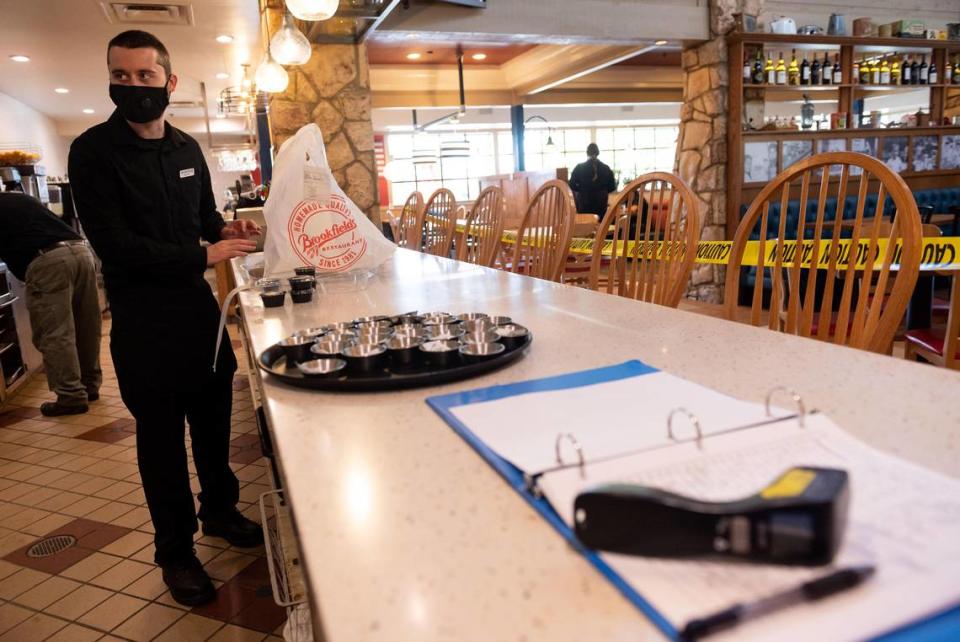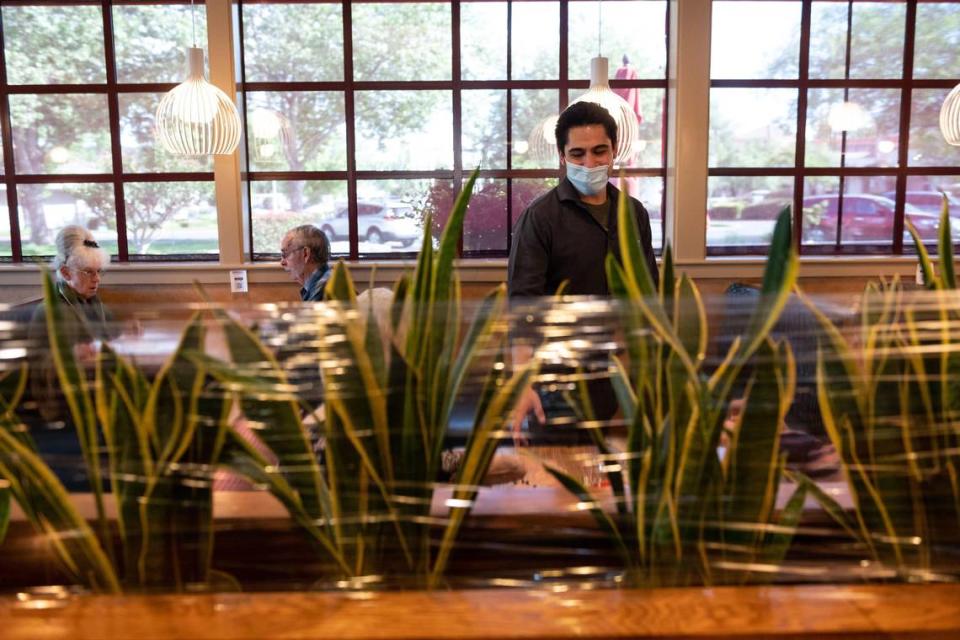Masks, online menus and hand sanitizer: Inside one of California’s 1st restaurants to reopen
Servers took orders in sleek black masks stamped with the restaurant’s logo. Every other booth sat empty with its tabletops removed and a vertical plastic wrap barrier separating customers from the next row over. Functioning bar stools were marked with caution tape, as were all but one restroom stall, which employees sanitized after every use.
A roomy diner founded in 1981 and mostly patronized by customers who predate that — dine-in customers 60 and older get a free tapioca pudding with their order — Brookfields Restaurant wasn’t prone to big changes prior to the coronavirus pandemic. But when the Roseville location got an opportunity to reopen and stop the bleeding from takeout-only service, Brookfields was game to follow whatever the state’s new rules required, said dining room manager Patricia Wysocki.
Not that customers cared much about the changes. Brookfields saw steady, not overwhelming traffic from couples and families through Friday’s lunch hours. The people there had been chomping at the bit to do so after two months of takeout and homemade meals.
“Just gotta bask in it,” one man in his 50s said as he slid into a booth. A woman in her 60s on her way out exclaimed, “it feels so nice not to have to bus my own dishes and wash them!”
“So far, everybody has been really open to and excited to be going out to eat,” Wysocki said. “They haven’t commented on the measures we’ve taken to reopen. They’re just happy the county is opening back up again.”
Placer County was among the first in California to be authorized to reopen certain brick-and-mortar economy sectors, including dine-in restaurant service, on Tuesday. Twenty-three counties had received state approval to begin reopening as of Saturday, nearly all of them in the state’s northeastern quadrant.
Brookfields started seating customers Thursday morning, less than 48 hours after California released a list of 99 requirements and recommendations for restaurants to follow upon reopening. The same changes will almost certainly apply when the restaurant’s Rancho Cordova and North Highlands locations get state approval to reopen as well.
All staff have their temperature taken and recorded in a signed log book at the start of every shift, Wysocki said. QR codes at every table take customers to online menus if they’d rather not handle the hard copies cleaned after every use, and hand sanitizer dispensers around the restaurant are touch-free.

Ranch and marinara for piping-hot fried zucchini wedges came in gravy boats, adhering to the state guideline against shared condiment bottles. My waiter brought a to-go container for my sesame-crusted seared ahi salad rather than box it up himself and leaned across the table to avoid touching my water glass while refilling it. He was washing his hands every 20 minutes, he said, and sanitizing hard surfaces around the restaurant that customers might contact at about the same frequency.
“I think (employees) are embracing it, they’re grasping it. You have old habits you have to change, but they’re very receptive, very coachable to the things we have to do,” Wysocki said. “The folks that are here are happy to be back to work and want to work.”
COVID-19 restaurant guidelines
Not every state recommendation was followed. Customers weren’t screened for symptoms upon entry. Bussers didn’t wear gloves when clearing dirty dishes. Disposable paper menus were only available upon request, not as the default. A communal bowl of mints sat by the host desk.
Perhaps most troubling, just one other person entered Brookfields with a mask during lunch despite guidance from the state saying all customers should wear them when not actively eating or drinking. And while all staff wore face coverings of some sort as recommended (or required, for front-of-house) two had pulled theirs down under their noses and one waitress dropped hers entirely to talk to customers.

“It’s an adjustment, a big adjustment,” Wysocki said. “It’s just breaking habits to the new normal.”
The restaurant was grossing about $1,000 to $1,500 in takeout while the dining room was closed, compared to $8,000 to $9,000 on weekdays and $12,000 to $13,000 on weekends prior to the shelter-in-place order, Wysocki said.
Those splits are why people like Sacramento Region Business Association CEO Joshua Wood so desperately want permission to reopen restaurants in Sacramento and Yolo counties. Though some like Roseville standout Nixtaco will opt against opening for dine-in service, those that want to serve sit-down customers should have the option to do so, Wood said.
“(Shelter-in-place) has been absolutely terrible for our restaurants, and not just short-term terrible. We’ve dealt with lots of restaurant owners who say they’re closing and closing for good,” Wood said.
But counties must have gone at least 14 days without a COVID-19 death, among other criteria to reopen restaurants, leaving May 26 as the earliest possible date for Sacramento County. Wood argued the county should be granted an exception to Gov. Gavin Newsom’s rule, citing the Sacramento area’s low infection rate compared to other metropolitan regions across the U.S.
Dining out has always carried the risk of food poisoning; the stakes are much higher now. A sit-down meal amid the coronavirus pandemic requires actively trusting that the restaurant’s managers and staff care as much about janitorial practices as they do creativity, taste and their bottom line.
And after months of physical distancing and reading about the virus’ destructive potential, diving back into an indoor social environment felt admittedly awkward. I found myself subconsciously inching further from customers eight feet away. My ears were primed for coughs or sneezes that never came. I vigorously scrubbed hand sanitizer after touching the menu, using the restroom, moving cutlery and touching my mask.
Not everyone, of course, felt the same trepidation. Wood said he’d eat at a restaurant but wouldn’t take his mother, who’s in her late 70s.
“I think there’s a lot of care and thought restaurants are putting into this,” Wood said. “It doesn’t remove 100 percent of the risk, and I’m not going to recommend that elderly people or people with autoimmune disorders go. But if you don’t fit in those categories, I think it might be a breath of fresh air to go out there as a consumer.”

